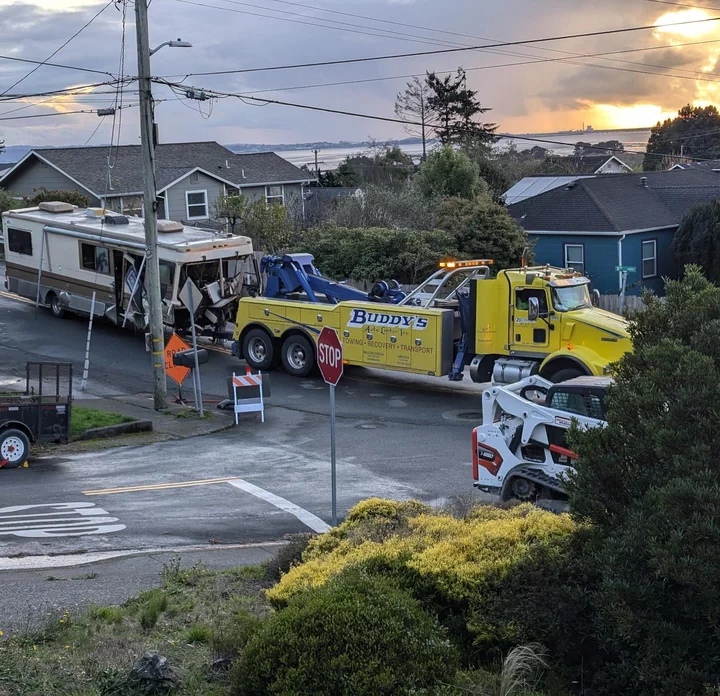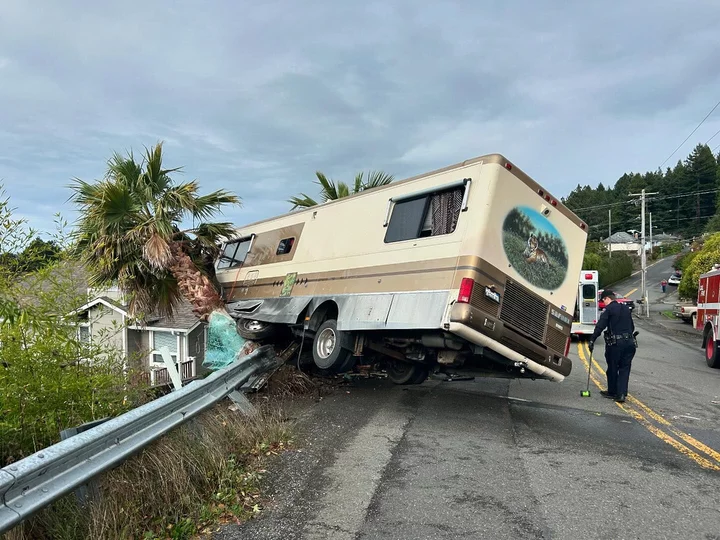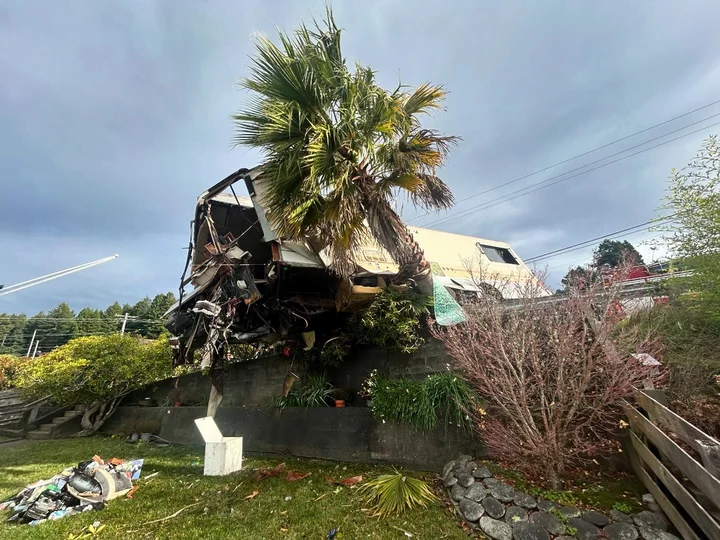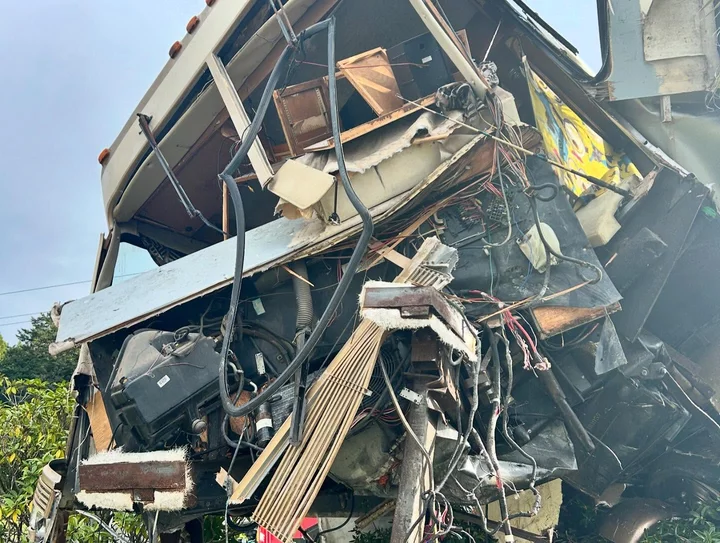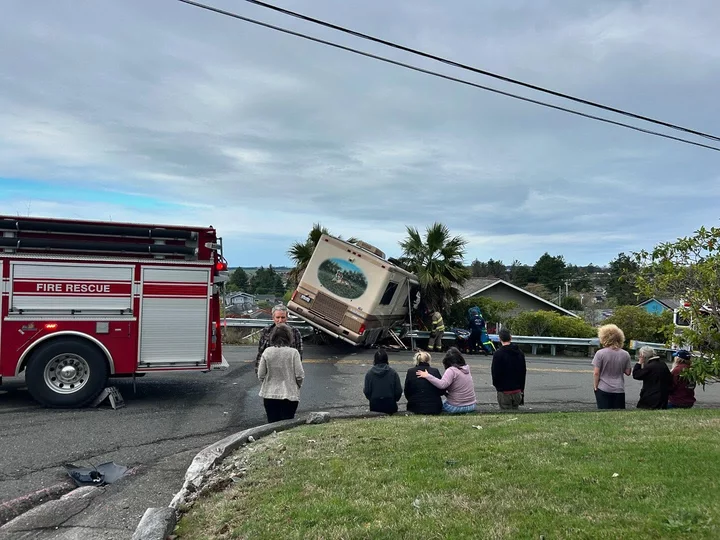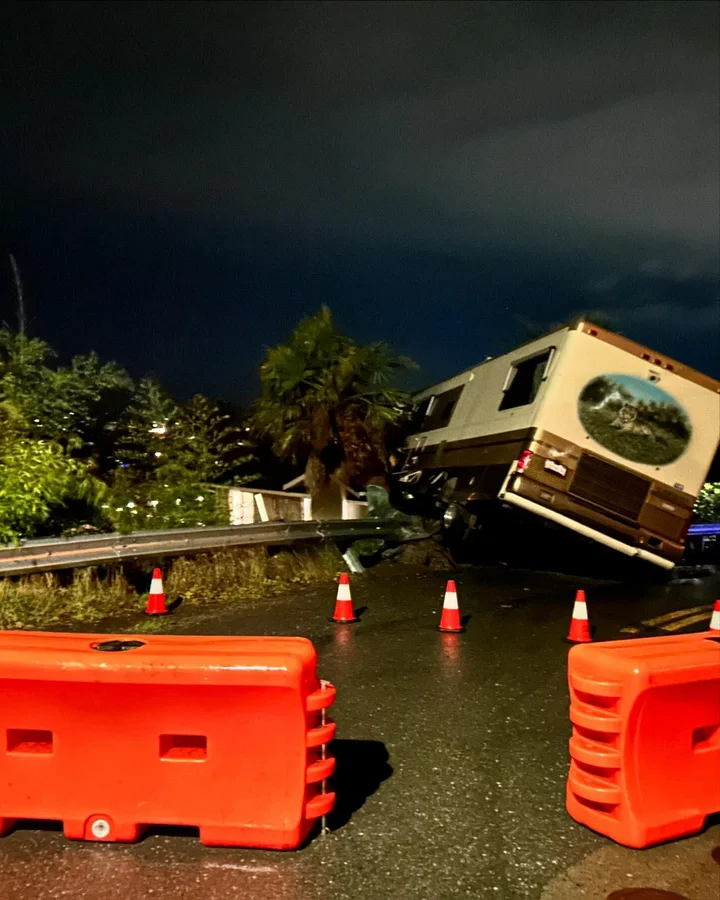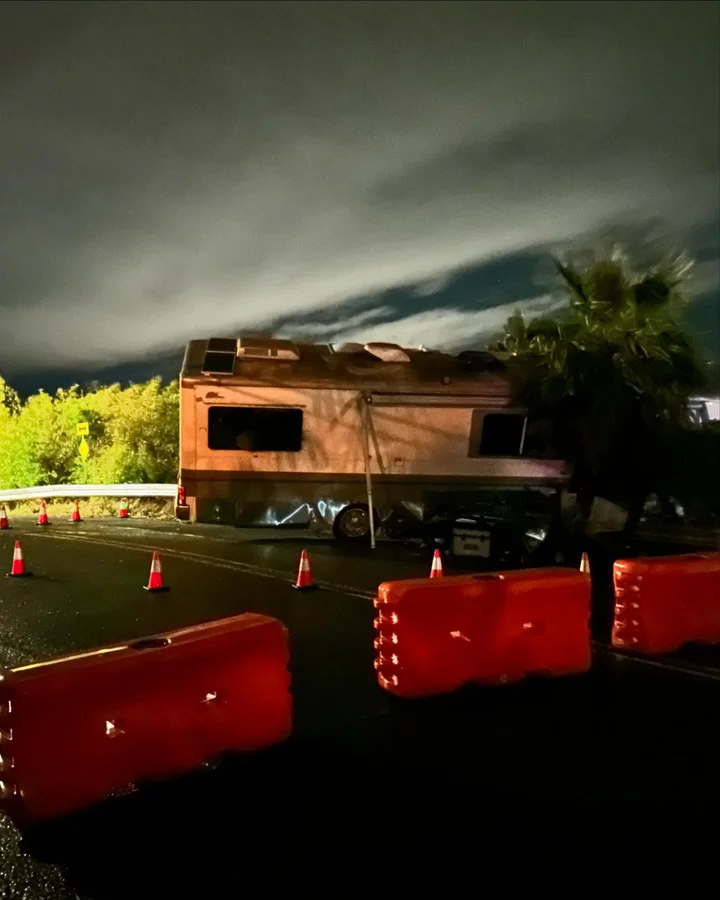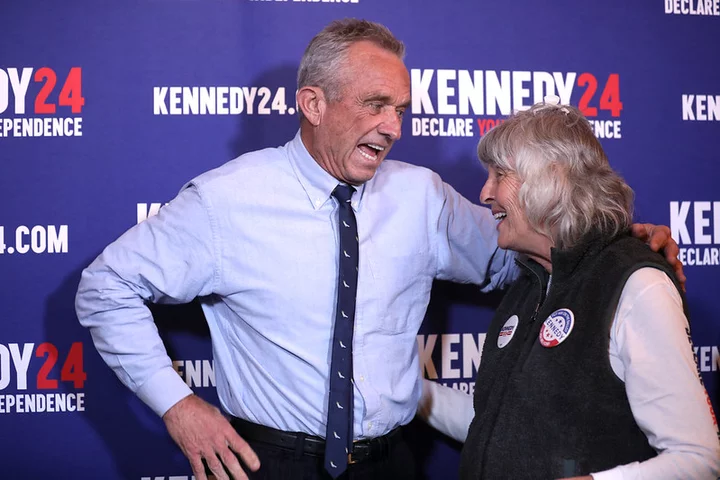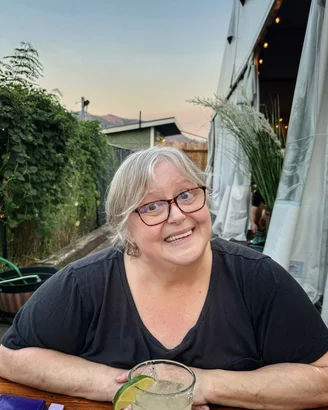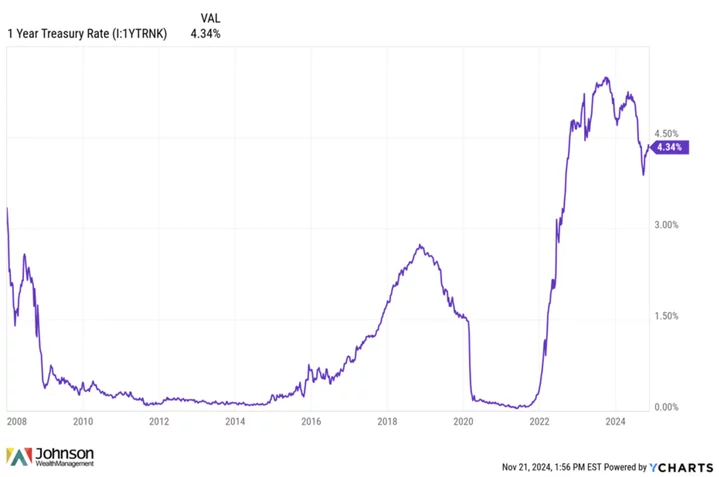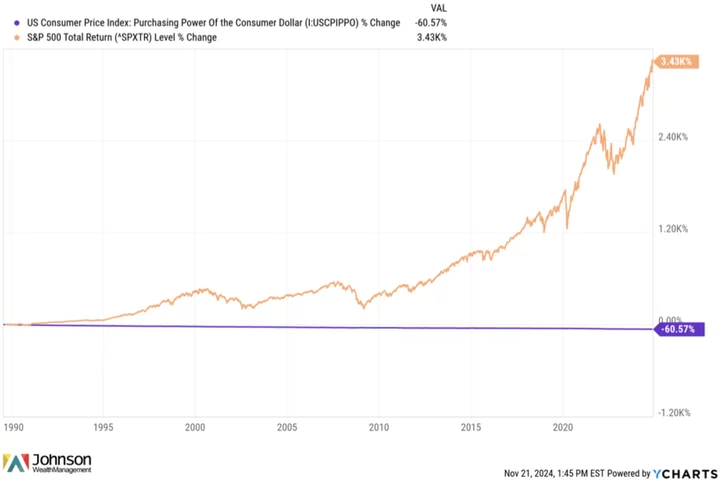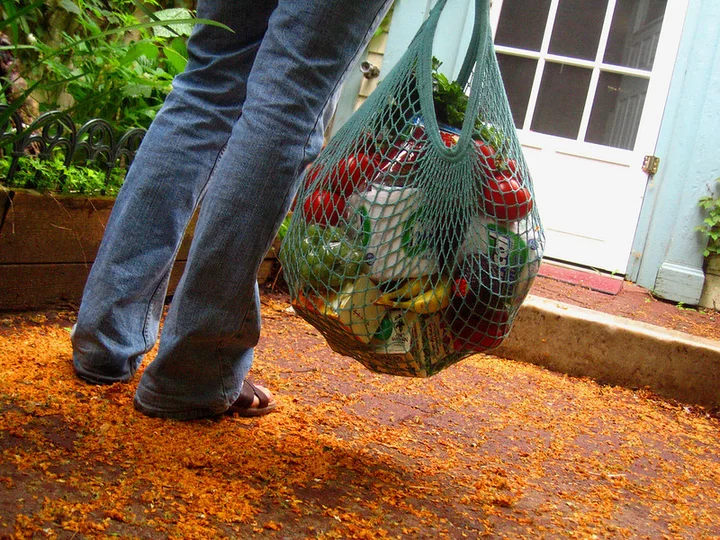(UPDATE: It Has Been Removed) Motorhome Loses Brakes on Fickle Hill and Comes to Rest Dangling Over a Bluff’s Edge in Arcata
Ryan Burns / Monday, Nov. 25, 2024 @ 12:39 p.m. / News
Photo by Scott Cocking.
UPDATE, Nov. 26, 10:30 a.m.:
Scott Cocking, the Arcata resident who snapped the photo above and all the ones below, posted an update on Monday evening showing that Buddy’s Towing successfully extracted the RV.
“They wrapped the front end with chains and lifted it with a Bobcat to get it on the tow arm,” Cocking reports via Facebook. “Nice job guys! Except for a leaning palm tree and some orange barriers, Fickle Hill is back and open for business.”
He issues a warning to cyclists, though: “The corner had diesel spilled from side to side. The city did a good job of soaking it up, but I wouldn’t hit that corner too hard for a few weeks of rain. Might be like ice!”
Good advice!
###
Original post:
Photos by Scott Cocking.
###
Some out-of-town travelers had a terrifying experience in Arcata on Sunday when their motorhome lost its brakes coming down Arcata’s steep Fickle Hill Road, causing it to collide with a parked car, a retaining wall and a palm tree before crashing through a guardrail and coming to rest half-suspended over a bluff near the bottom of the hill.
Arcata resident Scott Cocking, who captured the photos in this post, reported that everyone inside the vehicle, including a pet dog, survived the crash.
“The driver was taken to the hospital and was conscious and seemed in good spirits once they cut him out of the RV,” Cocking posted on Facebook.
The front end of the motorhome more or less disintegrated at some point during the extended crash, sending a pile of debris into the backyard of Cocking’s neighbor’s place.
The massive size of the vehicle has proved to be a problem for emergency responders. As of noon today the motorhome was still stuck in this spot and Fickle Hill Road remained closed.
An Arcata Police Department employee tells the Outpost that the city is waiting on equipment large enough to dislodge and tow away the massive RV.
BOOKED
Yesterday: 4 felonies, 18 misdemeanors, 0 infractions
JUDGED
Humboldt County Superior Court Calendar: Today
CHP REPORTS
No current incidents
ELSEWHERE
RHBB: Paving Work Scheduled Nov. 24–26 Between E Street and Spruce Street
RHBB: Reduce Food Waste This Holiday Season
RHBB: Coast Guard Rescuing Man Stranded 20–25 Feet Down Cliff in Shelter Cove
RHBB: Multiple Vehicles Strike Cows on U.S. 101 Near Cummings, South of Leggett
Humboldt’s Ryan Petersen Brings Home the Win in His First BKFC (Bare Knuckle Fighting) Bout
Hank Sims / Monday, Nov. 25, 2024 @ 12:05 p.m. / LoCO Sports!
Congrats to Humboldt’s Ryan Petersen, who on Saturday fought in his first Bare Knuckle Fighting Championship circuit match and walked away with the technical knockout victory over Canadian Dan Godoy.
As you can see in the video above, the referee stopped the fight at the end of the second round after Petersen landed a hard right to Godoy’s eye. The ringside medical staff at Los Angeles’ Thunder Studios would not permit Godoy to fight through.
The announcers at Fox Deportes were taken by surprise.
Petersen has previously fought at local events, including Rumble at the River IV earlier this year.
RFK Jr. Was on the Losing Side of California Vaccine Fights. Now, Trump Wants Him in His Cabinet
Ana B. Ibarra / Monday, Nov. 25, 2024 @ 7:56 a.m. / Sacramento
Robert F. Kennedy, Jr. speaking with a supporter at a campaign rally at the Fox Tucson Theatre in Tucson, Arizona. Photo: Gage Skidmore, via Flickr. License: CC BY-SA 2.0
Five years ago, hundreds of people crowded the halls of the state Capitol protesting legislation that sought to tighten California’s vaccine rules. Outside, music blasted something about a revolution and people carried signs that read “Vaccine mandates violate bodily autonomy.”From the sea of red-clad protesters emerged a familiar face idolized by the anti-vaccine activists: Robert F. Kennedy Jr.
He was the guest of honor in one of the biggest public health showdowns the state has seen in recent years. Ultimately, he and his followers lost — the Legislature passed a law to clamp down on fraudulent or inappropriate medical exemptions for required childhood vaccines.
Today, Kennedy finds himself on a bigger stage with potentially far more influence and power. President-elect Donald Trump has nominated the former environmental lawyer turned controversial vaccine critic to oversee the nation’s health policy as secretary of Health and Human Services.
He has been known to make false, and at times dangerous, claims about medicine and public health. Perhaps most infamously he linked vaccines to autism — a claim that has been debunked over and over again.
Now with Kennedy in the running to lead the federal health department, health leaders and advocates in California and across the country are voicing their concerns and preparing to combat a potential wave of medical disinformation.
Having a vaccine skeptic at the helm of the U.S. Health and Human Services agency, some say, could lead to more Americans refusing to be vaccinated and potentially put lives at risk. It could also embolden the anti-vaccine movement in California.
Dr. Richard Pan, a pediatrician who as a state senator authored the 2019 medical exemption law and a separate law that eliminated personal belief exemptions for childhood vaccines, said having a health secretary who casts doubt on vaccines is “a danger” and “disturbing.”
“I imagine we’re going to see a lot more direct attacks on individual scientists, individual people. I’m anticipating that I’m probably gonna be hoisted somewhere by those guys as well. I don’t think RFK Jr. has forgotten about me yet,” he said.
Pan said he’s met Kennedy twice when Kennedy traveled to Sacramento to oppose his bills.
Carrying those laws made Pan the subject of harassment and attacks, and at one point an anti-vaccine activist shoved him while Pan was walking in a Sacramento street. At protests, anti-vaccine activists plastered Pan’s face on posters with the word “LIAR” in red letters.
Now, people who rallied against his vaccine bills are celebrating Kennedy’s potential spot on Trump’s cabinet, and calling for “justice” via social media posts.
In one of their last quarrels, Pan publicly called for Kennedy to be banned from social media platforms when Kennedy promoted COVID disinformation. In response, Kennedy told the Sacramento Bee that Pan’s request for censorship was anti-American.
More recently, Kennedy has taken a more measured approach when responding to questions about vaccines. Following Trump’s win he told NBC News that he isn’t looking to take vaccines off the market, but rather is advocating for informed choice.
“If vaccines are working for somebody, I’m not going to take them away,” he said.
What can RFK Jr. do as health secretary?
If Kennedy is confirmed as head of Health and Human Services, he would oversee a $1.7 trillion budget and about a dozen agencies. He would be responsible for managing pandemic preparedness, and would be in charge of issues ranging from health insurance to food safety.
Experts say that any controversial changes would likely be met with litigation that could slow or derail Kennedy’s proposals. Still, there are several ways anti-vaccine sentiment in the federal government could undermine public health gains in states.
For example, school immunization mandates are issued by states and while the federal government cannot directly change those, it could decide to withhold public health funding, such as grants sent to states to help fund vaccination efforts, said Dorit Reiss, a professor at UC Law San Francisco.
As health secretary, Kennedy would also have the power to appoint members of an advisory committee that makes recommendations on immunization practices to the U.S. Centers for Disease Control and Prevention.
Reiss added that the health secretary also has the power to expedite or limit access to new vaccines, which would become especially important in the case of another pandemic.
It is the secretary of Health and Human Services who declares a public health emergency and issues emergency use authorization for unapproved vaccines. When COVID shots were first made available to the public in December 2020, they were allowed under this emergency designation. The U.S. Food and Drug Administration fully approved the vaccine for people 16 and older nine months later.
A secretary hostile to vaccines could block or remove the emergency use authorization. That means the vaccine manufacturer “would have to either apply for full approval at the moment or not sell the vaccine,” Reiss said.
Kennedy told NBC that he wouldn’t have “directly blocked” the emergency use of COVID-19 vaccines had he been secretary at the time, but rather would have made sure that “we have the best science.”
Yet at the height of the pandemic, Kennedy helped fuel mistrust of the coronavirus vaccine. In 2021, he called it the “deadliest vaccine ever made” in opposition to a Louisiana proposal that would have required school children to be vaccinated against the virus.
California vaccine mandates
In 2010, the California Legislature passed a law that added a booster of the pertussis vaccine, which protects against whooping cough, to the immunization schedule for teens to attend school. Catherine Flores Martin, the executive director of California Immunization Coalition, a nonprofit that advocates for vaccines, remembers when lawmakers were considering this bill, roughly about 18 people or so showed up in opposition, she said.
Fast-forward to 2015 and 2019, opposition to vaccine legislation evolved into mass protests of hundreds of people. “It’s gotten wild,” Flores Martin said.
“The vast majority of parents still vaccinate their children,” she said. “We hear a lot about hesitancy, but hesitancy doesn’t convert into not vaccinating.”
In the 2021-22 school year, 94% of California’s kindergarteners had received the required vaccines, the state’s public health department reported.
But Flores Martin acknowledges that it has become more challenging to pass vaccine legislation as opposition has become louder in California. She attributes this in part to the growing role of misinformation shared on social media platforms.
State public health officials did not respond to an interview request by deadline.
The year 2014 was notable in public health for a couple of reasons. That year whooping cough infections peaked, with more than 11,000 cases reported in the state, the most ever. Also, in December of that year, a measles outbreak at Disneyland contributed to the highest number of measles cases reported in the U.S. in two decades. Most of the cases were among unvaccinated children. The outbreak resulted in hospitalizations but no deaths were reported.
In California, the vaccine that protects against measles, mumps and rubella is among the required doses for kids to attend school. So is the polio vaccine and the Hepatitis B vaccine, among others. It was this measles outbreak that led the Legislature in 2015 to remove personal belief and religious exemptions for required shots.
Then in 2019, lawmakers came back and approved a second law that allowed the state’s Department of Public Health to review and revoke inappropriate medical exemptions. Medical exemptions have to be made by a physician and are reserved for small groups of people, such as those who are allergic to vaccine ingredients.
Following the 2019 law, the rate of kindergarteners with medical exemptions decreased to the lowest levels since 2015-16, according to the state’s public health department. However, research shows that because of disruption in routine doctor visits during the pandemic, the number of kindergarteners who were not up to date on their immunizations ticked up.
Health advocates and experts say that it is now more important than ever to instill confidence in vaccines and proven public health measures. Flores Martin said doctors and health advocates will have to band together and push vaccine education to maintain high immunization rates. The messaging matters, she said.
###
Supported by the California Health Care Foundation (CHCF), which works to ensure that people have access to the care they need, when they need it, at a price they can afford. Visit www.chcf.org to learn more.
CalMatters.org is a nonprofit, nonpartisan media venture explaining California policies and politics.
OBITUARY: Renee Leanne Isaacson, 1961-2024
LoCO Staff / Monday, Nov. 25, 2024 @ 6:56 a.m. / Obits
Renee Leanne Isaacson passed away on September 19, 2024. She was born on April 24, 1961 in Goldendale Washington. Renee grew up in Carson, Washington and met Eric Isaacson in 1985 around the time Eric moved up there. They got married on July 6, 1991. Eric worked at a couple mills and then did timber falling, while Renee worked in a psychiatric ward at Vancouver hospital. They moved in together in 1986 in Carson, Wash. and then moved to Eureka in 1990. They got married on July 6, 1991.
Renee worked in the health center at HSU as a referral coordinator for insurances. She retired early in 2005 to become a stay-at-home mom for her twins, who were seven at the time.
She is survived by her husband Eric, her son Michael, and her daughter Molly.
Written by Molly Isaacson:
My mom was kind, light-hearted, and had an amazing sense of humor. She was hilarious and very quick-witted! I have so many of her funny quotes written down. Mom was creative and did many different crafts throughout the years. She painted rocks, canvases, and then got into sewing in 2020. She had turned a room in their house into a “craft room” and it was filled with any fabric you could think of! She made masks during the pandemic, but then transitioned to making rice packs, bags, bowl cozies, ornaments, bows, baby blankets, gnomes, and more. Mom’s favorite activity was sewing in the craft room and listening and singing along to music playing on the Alexa. Speaking of Alexa- she had one in every room! My brother and dad never quite understood, and it almost became a joke to see what they’d say about her growing collection. For the last few years, mom attended a couple craft fairs a year including the veterans memorial building craft fair and the Loleta craft fair to sell her sewing creations. I would go with her and help out and we’d spend the day chatting (and shopping the other vendor booths) together.
My mom also loved Disneyland, taking many trips over the years with her relatives Carla, Heidi, Mitchell, Alexandria, Beatrice, my brother and I (and my dad a couple times)! Her favorite was when it was decorated for Christmas, which we got to see on our last trip out there in 2018.
My personal favorite memories with mom are our family trips up to Washington to visit family. We have gone to Washington almost every summer for as long as I can remember and I have so many fond memories of those adventures. We would play music in the car and eat road trip snacks and just have the best time ever being with family. As my brother and I became adults, we would drive up ourselves and meet mom up there. Mom would sometimes visit there for a month at a time and it truly was one of her happy places. This past July, my partner and I drove up to Washington with mom! It was just like old times when we would all drive up together. We stopped at Burgerville on the way up (it’s a necessity) and then went out to Backwoods Brewery once we made it to Carson. It was a beautiful, warm night and the excitement for the upcoming week of adventures was tangible. Later that week, we visited Mt. Hood because mom had never been there. It was beautiful and extra special looking back, now.
I am extremely grateful for the memories I have and for my mom and dad for giving my brother and I the best childhood ever. We were such happy kids and our days were filled with magic, especially this time of year. My mom LOVED Christmas. Growing up, she did not get to experience Christmas magic but it made her go above and beyond so that my brother and I would always have the best Christmas ever. Our tree would be up extra early - oftentimes before Thanksgiving! My dad and brother were in charge of putting up the lights outside and they always did a beautiful job. She loved snow globes and Christmas music and we used to watch the Christmas Story 24-hour marathon every year!
My dad told one of my favorite stories that I have heard of my parents: January 1986, Renee and I decided to drive up to catch the sunrise in the snow. We got stuck in the snow and I went out in the woods to gather slabs of cedar to use for planks to put behind the wheels to get unstuck. I was pushing and she was driving. I didn’t realize at the time but she had no idea how to drive in reverse. I told her to back up and go down the main road. She accidentally got off the main road onto the side road and got stuck in the ditch and I had to do the same thing all over again! She ended up in the ditch about twice. We finally got to a spot where she got out and we were able to drive back home. We used to drive out the logging roads because I was familiar with those since it’s what I was doing while timber falling. We got stuck more than once. When we moved down here to Eureka, she wanted to go to Samoa beach and we got stuck and had to sleep overnight in the car. She could hear the ocean and swore the tide was going to come up and reach us. — Eric Isaacson
To know Renee was to love her, and she is so missed. Grief is just love. It’s the love you want to give, but cannot. How lucky are we to be filled with so much love for my beautiful mom …
###
The obituary above was submitted on behalf of Renee Isaacson’s loved ones. The Lost Coast Outpost runs obituaries of Humboldt County residents at no charge. See guidelines here. Email news@lostcoastoutpost.com.
TO YOUR WEALTH: Weathering Financial Storms: The Virtue of Emergency Funds & The Vice of Safetyism
Brandon Stockman / Sunday, Nov. 24, 2024 @ 7:05 a.m. / Money
It’s been a stormy week on the Lost Coast.
How do you prepare for financial storms that life will inevitably bring?
One of the best ways is through building an emergency fund. This is step one in personal finance, and the training wheels of money management. Let’s use an educator’s interrogative grid to nail down the fundamentals.
Who? Answer: YOU. You should have an emergency fund. Whether you are old or young, retired or still working, a seasoned or amateur investor, everyone should have one.
Why? It protects you from having to go into debt when life throws you a curveball. Jobs are lost. Vehicles break down. Earthquakes break things. Medical problems seemingly arise out of nowhere. When these kinds of events occur, you can run to your fund instead of giving in to the allurements of the credit card.
The “whys” don’t have to all be reactive though. Emergency funds can help prepare you to proactively not “stay stuck” and give you a pathway to switching careers or moving to a new place.
What? This is not an investment account. Boredom is the goal. The important thing is: it should be risk-free. Avoid investment risk and avoid terms that have penalties for withdrawal. Remember the reason for an emergency fund is so that the money is there when you need it and not at a value less than what you started with.
Where? Not in your checking account, that’s for sure. Normally the money should be earning interest in an FDIC-insured account, money market, or high-yielding savings account. After all, the current interest rate on “safe” money, which can follow US Treasuries, is higher than it has been for many years.
Click to enlarge
The key is to make your emergency fund easy—but not too easy—to access. Therefore, you might consider putting it in a high-interest savings account at a different bank than the one you regularly use as a psychological buffer. This helps you think twice before pushing the button to transfer it into your checking.
When? NOW. If you don’t have one, don’t wait another minute to start one. Go to your local bank or look for an online one. You could start setting one up faster than reading this article.
How? There are two of these Hs: how should I build this fund and how much should I put in it?
The answer to the first question is: set up an automatic withdrawal amount each month. Whether it is $50 or $500, this should automatically be set up monthly. If you make it manual, human nature will kick in and suddenly months will slide by without the account accumulating.
The answer to the second question is a bit more debatable. Three to six months of living expenses seems to be the standard. Some even say a year’s worth. I say, start with one month and build from there.
But if you’ve built past a year or two into multiple years, you’ve likely moved away from an emergency fund into an “End of the World” fund. The error of this is that your fear of risk is now munching away at your fund’s value by the stealthy inflation monster. You may need to consider investing.
After all, emergency preparedness can be a virtue, but it can also become an addiction that is a vice. This occurs when it’s no longer about preparing for crisis, but about control.
A significant part of life is engaging in risk. Safetyism can be a disease. Or, as the authors of The Coddling of the American Mind write: a cult.
Safetyism is the cult of safety—an obsession with eliminating threats (both real and imagined) to the point at which people become unwilling to make reasonable trade-offs demanded by other practical and moral concerns.1
While the authors are focused on how this way of thinking impacts children and the next generation, it can be applied in finance too. Being so obsessed with safe investments and anticipating the next emergency can hijack your future. It makes you think you’re planning for the future, when you actually aren’t. Safety, to use the word of Gollum, can be “tricksy” like that.
You can sit in government bonds forever or have cash in your local bank till kingdom come. Inflation will still eat it. You can put your money in a safe inside your house inside your gated community, and it will do just that—sit there.
Investing in stocks has been one of the best ways to beat inflation. While the purchasing power of the dollar has dropped significantly through the decades, the US Stock Market has done quite well.
Yes, prepare for the storms of life and have and emergency fund, but don’t make that your only long-term financial plan.
# # #
Sources:
- 1 Greg Lukianoff & Jonathan Haidt, (Penguin Books, 2019), p. 32.
Brandon Stockman has been a Wealth Advisor licensed with the Series 7 and 66 since the Great Financial Crisis of 2008. He has the privilege of helping manage accounts throughout the United States and works in the Fortuna office of Johnson Wealth Management. You can sign up for his weekly newsletter on investing and financial education or subscribe to his YouTube channel. Securities and advisory services offered through Prospera Financial Services, Inc. | Member FINRA, SIPC. This should not be considered tax, legal, or investment advice. Past performance is no guarantee of future results.
TINY FOOTPRINTS: Plastic Grocery Bags Are Going Away Entirely in Another Year, And You’re Gonna be Totally Ready For That Because You Are Awesome
Ashley Thomas / Sunday, Nov. 24, 2024 @ 7 a.m. / Tiny Footprints
Photo by flxlr, via Fickr. License: CC BY-NC-SA 2.0.
The phrase “the road to hell is paved with good intentions” always rubbed me the wrong way. So judgy. And yet, that’s what comes to mind when I consider the 2014 California ban on single-use plastic bags. It was a fantastic idea, and I have no doubt that the people who set it into motion had the very best of intentions.
Unfortunately, the ban led to a loophole in which stores were able to sell thicker plastic bags. According to CalRecyle, the average Californian disposed of about 11 lbs. of grocery bags per year in 2021—which is up from about 8 lbs. in 2004. Making bigger, thicker (albeit reusable) plastic grocery bags just created a bigger problem.
Yikes!
So, why does it matter? Well, despite these thicker plastic bags being reusable, they continue to end up in landfills, where they can take centuries to break down. In the meantime, the chemicals in these bags contribute to microplastics in our environment and bodies. Plastic can disrupt the human endocrine system, harm wildlife, and increase greenhouse gas emissions, just to name a few concerns.
So, what can we do about it?
• Use those reusable plastic bags. If you’ve already purchased them and they remain in your possession, do your best to bring them in from the car. If you forgot them in the car, have your friend, kid, or significant other grab them before you pay. And if you’re shopping alone, you can even pack the groceries back into your cart and transfer them into the bags when you get to the car. Or your home, if that’s where you left them. Sure, it’s inconvenient, and if it’s one of those days when you just can’t, that’s understandable. The point is progress, not perfection.
• Invest in reusable cloth bags. I carried my reusable plastic bag torch for years. I’d bought them, so I felt compelled to keep using them. But over the years I became resentful of them. Resentful of the amount of physical space they took up. In my home. In the shopping cart. That with wear and tear they became an eyesore. It sounds dramatic, yet I’m sincere when I say that purchasing reusable cloth grocery bags changed my life. Mine fold up into a tiny attached compartment, so I can throw them into my purse, where they take up hardly any space. They also fit 2-3 regular bags worth of groceries, and boast supporting up to 50 lbs. And of course, they come in an absurd array of colors and patterns to fit your personality. But any cloth bag will do—canvas, your backpack. You do you, boo.
• Consider alternatives to produce bags. When you’re picking out your apples or grapefruits from Winco, consider avoiding single-use produce bags altogether. If it’s just a few items, you can toss them in the cart and throw them on the conveyer belt. If you’re going for something like mushrooms or chili peppers, you could repurpose other kinds of bags (I think sturdy tortilla bags with zippers and bread bags are perfect for this). Or, you could invest in reusable produce bags. The mesh ones I found are food safe, BPA-free, and machine washable.
The bottom line: There’s not one “correct” way to cut back on plastic bags. If you’re already on the reusable grocery bag train, congratulations and thank you! If not, the goal is to find a strategy that works for each of us most of the time, and try to stick to it. It’s not going to solve all our problems, but I believe small changes at the individual level can turn into bigger changes within our community and world over time.
Oh, and by the way, California recently passed a new law that will ban the sale of those thicker, reusable plastic bags anyway. Starting January 1, 2026, recycled paper bags will be the only option for purchase at checkout. So it’s a great time to get another system in order before that takes effect. And I personally think the compact, foldable grocery bags make an adorable stocking stuffer for adults.
###
Ashley Nichole Thomas is a marriage and family therapist who’s passionate about shrinking her carbon footprint. In her free time she writes fantasy novels, and remains unconvinced that fairies don’t exist.
(VIDEO) Peter Santenello’s Latest Video ‘Life in the Middle of Nowhere - California’s Most Secluded Tribe’ Explores the Hoopa Valley Reservation Through the Eyes of Locals
Isabella Vanderheiden / Saturday, Nov. 23, 2024 @ 2:54 p.m. / Our Culture , Tribes
###
YouTube travel vlogger Peter Santenello is back with another video highlighting our beloved Humboldt County!
Just last week, Santenello published a video – “The California Nobody Knows” – about his adventures around Crazy River Farm, the Arcata Farmer’s Market and the redwoods with local farmer and songwriter Brett McFarland.
In his latest video, which has already racked up 152,000 views since it was posted this morning, Santenello travels out to the Hoopa Valley Reservation to chat with locals and learn more about the history of “California’s most secluded tribe.” Sam Jones, a Hoopa tribal member and tattoo artist, takes Santenello on a tour of the rural reservation and introduces him to a few family members and friends who describe the desperate situation facing their community.
“If you want to get down to it, the drug use is pretty rampant,” Jones’ friend Samuel says in the video. “It’s fentanyl and heroin, too. It hinders progress … because if you’re messed up on drugs, you never know the true potential of a person because they’re always, like, shortchanging themselves. Or else they just get taken out too quick because they die. [We]’re losing a lot of bloodlines from people passing away.”
Even so, Jones tells Santenello that he has an “uplifting sense of pride” for his community. “We’ve been here for 10,000 years,” Jone says, looking out over the Hoopa Valley from a vista point. “We’re going to be here forever, you know?”
Click “play” on the video above to tag along on Santenello’s journey to the Hoopa Valley.
###

